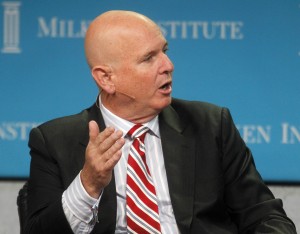
- AB 2833 requires CA pensions to make reasonable effort to collect, report on fund fees
- CalPERS, UC Regents included older funds in reports
- CalSTRS staff concerned about releasing fee, expense data from older funds
California State Teachers’ Retirement System declined to release information about the fees and expenses charged by its older private fund managers, limiting insight into the myriad costs private equity firms impose on investors.
A state law that took effect last year, AB 2833, requires general partners who raised fresh capital from organizations like CalSTRS or California Public Employees’ Retirement System to disclose their annual fee, expense and performance data to their investors.
In turn, California’s public institutional investors will use that information to produce annual reports detailing the specific fees and expenses charged by each of the firms in their private equity portfolios.
The law doesn’t apply to fund managers who received commitments from California institutions prior to 2017. However, institutions like CalSTRS and CalPERS are now obligated to make reasonable efforts to obtain and release fee and expense information from those firms.
Approaches vary
Institutions have varied in how much information they included in their respective reports. Unlike CalSTRS, recent AB 2833 reports published by CalPERS and UC Board of Regents identified the underlying fees and expenses charged by the managers of older funds.
The Board of Regents went so far as to identify firms that failed to respond to their requests for information.
CalSTRS limited the material included in its report after staff members voiced concerns that the retirement system lacked authorization to release certain information relating to performance, fees and expenses, Associate Portfolio Manager Shifat Hasan told Buyouts in an interview.
There were also issues relating to the uniform reporting of certain fee or performance figures, such as gross internal rate of return.
GPs offered little pushback on the prospect of their fee and performance data being released to the public, Hasan said. But while most firms responded to CalSTRS’s inquiries about fees and expenses, the breadth of those responses was relatively limited.
“If I remember correctly, most of the GPs didn’t have any problem,” Hasan said.
Trade secrets?
Many public pensions consider PE fees and expenses trade secrets whose release could diminish their ability to access certain funds. Prior to becoming law, investment staff at CalPERS and other California public pensions recommended their respective boards oppose AB 2833 on those grounds.
Some objectors also noted AB 2833 would require staff to collect and compile large amounts of data, eating into valuable time and resources. A CalSTRS staff memo offering tentative support for AB 2833 noted the law’s requirements could increase the system’s administrative costs by more than $500,000.
CalSTRS’s future AB 2833 reports will likely include more fee and expense information about older funds, along with the newer vehicles already covered by the report, Hasan said.
CalSTRS is “working with the GPs to bridge the gap in the coming years,” she said. “It’ll be a process.”
Over the past two years, CalSTRS independently produced an annual investment-cost report to provide a look at the aggregate fees and expenses charged by its different investment platforms.
The most recent cost report, presented at the board’s November meeting, found that CalSTRS paid $334 million in PE-related management fees, operating costs and other expenses in 2016.
Private equity represented 8.5 percent of CalSTRS’s assets during the period captured by the report. It also accounted for more than a third of $973 million in fees and expenses paid out by the retirement system’s total investment program in 2016.
Despite its steep costs, PE has consistently performed strongly for CalSTRS. The program has delivered a 13 percent IRR since 1988, consultant Meketa Investment Group’s most recent report on the program shows.
PE outperforms
The CalSTRS PE portfolio outperformed both the State Street PE Index and its custom benchmark (the Russell 3000 public equity index, plus a 3 percentage point or 5 percentage point premium, depending on the vintage).
Its recent performance has been a little more mixed. The program was underperforming its benchmarks over three- and five-year time horizons, the Meketa report says.
The retirement system is exploring changes that would give its staff more room to invest in niche private equity strategies including direct investments and more co-investments, Buyouts reported last year.
In March, CIO Christopher Ailman reportedly told board members that staff is crafting a proposal to collaborate with other institutional investors on certain alternative investments.
CalSTRS’s PE portfolio is valued at around $17.2 billion. The retirement system’s investment program is valued at roughly $224.4 billion.


 If you do not receive this within five minutes, please try and sign in again. If the problem persists, please
email:
If you do not receive this within five minutes, please try and sign in again. If the problem persists, please
email: